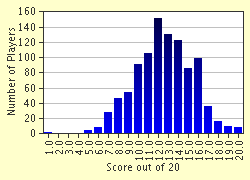Quiz Answer Key and Fun Facts
1. Earth rotates in about how many hours?
2. Who formulated the geocentric theory?
3. Who formulated a heliocentric theory and is often described as the father of modern astronomy?
4. What is the axial tilt of the Earth?
5. The Earth's diameter is approximately how many kilometers?
6. Earth has how many natural satellites visible to the naked eye?
7. What was the giant land mass called that existed some 200 million years ago?
8. According to the conventional definition of "continent" used by "National Geographic" magazine and, as taught in the USA, the Earth has seven continents.
9. Earth is the densest of all of the Sun's planets.
10. The Earth's average distance is how many kilometers from the Sun?
11. The Earth is the ___________ planet from the Sun.
12. The Earth is a _________________ planet.
13. Earth's atmosphere consists mostly of?
14. When the Earth is directly between the Sun and the Moon it is called what kind of eclipse?
15. Earth is moving around the Sun at about __________ miles per hour?
16. Earth's inner core is believed to be primarily solid.
17. The largest known impact crater on the Earth is the _________________.
18. The highest mountain on the Earth, measured conventionally from sea level, is ________________.
19. What is the second highest mountain on the Earth, measured conventionally?
20. The deepest depression on the Earth is called what?
Source: Author
almach
This quiz was reviewed by FunTrivia editor
crisw before going online.
Any errors found in FunTrivia content are routinely corrected through our feedback system.


